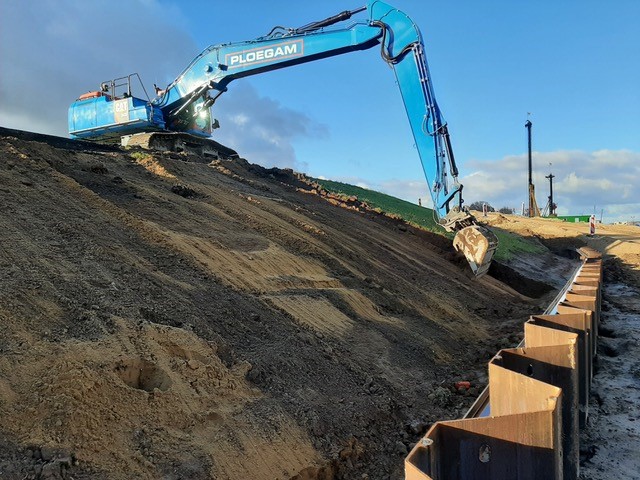For the reinforcement of the Gorinchem-Waardenburg (GoWa) dyke in the Netherlands, ArcelorMittal Projects and ArcelorMittal Sheet Piling provided 6 kms of steel sheet piles, produced in Belval, Luxembourg. Our sheet piles not only protect the dyke against the risk of failure, but also help to reduce the environmental impact of the project, thanks to the reuse of used sheet piles, themselves made from recycled steel.
A country vulnerable to flooding
Water control in the Netherlands has always been important for the country's survival: about two-thirds of the Netherlands is vulnerable to flooding and sea surges, while one-third of the country's surface is below sea level.
The first major hydrological works to reclaim land from the waters date back to the 13th century, and today a network of more than 17,500 km of dykes protects the 6,000 km of canals that run through the country. In particular, 3,750 km of dykes form the primary flood defence, protecting the Netherlands against flooding from the North Sea, the Wadden Sea and the main rivers.
Following the dramatic floods of 1953, the major 'Delta' plan was launched to improve the safety of the reclaimed land. It is estimated that the risk of flooding has been reduced to less than once every 4,000 years in Zeeland and even once every 10,000 years in the Rotterdam area. Dyke reinforcement and raising work continues across the country, especially on the 1,850 km of dykes that do not yet meet the safety standards required by 2050.
Reinforcing the Gorinchem-Waardenburg dyke with ArcelorMittal's sheet piles
For the reinforcement of the Gorinchem-Waardenburg dyke in the Netherlands, ArcelorMittal Projects and ArcelorMittal Sheet Piling provided steel sheet piles to customer Graaf Reinald Alliantie for more than 6 km of the 23 km long dyke. Sheet piles were the ideal solution to support and reinforce the structure against failure, especially where the surrounding space is limited and does not allow for the extension of its footprint on the ground.
Moreover, due to the scope of the project and the recent inclusion of environmental criteria in Dutch tendering procedures, the environmental impact of the selected solutions needed to be reduced as much as possible.
The project owner and ArcelorMittal worked together to reduce the carbon footprint of the project by applying the three important principles of the circular economy: Reduce, Reuse, Recycle.
Reduce, Reuse, Recycle
Innovation in steel and rolling technology, as well as in installation equipment, has made it possible to reduce the quantity of steel needed to make the same retaining wall by more than 50% in a few decades. The engineering offices select the best technical solutions to optimise costs, total steel weight, resource consumption and environmental impact. On the GoWa project, the sheet piles have been supplied with high quality S430 GP steel, to achieve the required strength with a lighter sheet pile profile and reduce the environmental impact.
Tests made by the public research programme 'POV | Macrostabiliteit' in the Netherlands, showed that it is possible to select shorter and lighter sheet piles than has been done so far, in order to optimise the total volume of steel in this type of project.
Although the reuse of used steel sheet piles is an excellent solution for temporary applications, they are more rarely used in permanent structures such as dyke reinforcement. For the Gorinchem-Waardenburg project, the client Graaf Reinaldalliantie deliberately selected used sheet piles. In locations where there was a risk of hydraulic failure, a used sheet pile wall can fulfil this function as well as a new sheet pile wall. The main difference is that the total greenhouse gas emissions from the production phase of the steel sheet piles do not have to be included in the environmental balance of the project, as they have already been partially included in the previous temporary applications.
ArcelorMittal's sheet piles, produced in Belval mill in Luxembourg, use low-emission modes of transport such as railways and waterways. The steel is produced by the electric arc furnace (EAF) process, which produces less residue than primary blast furnace production, and with up to five times less CO2 emissions.
Our new EcoSheetPile™ Plus brand of steel sheet piling, part of our XCarb® recycled and renewably produced initiative, takes a further step by using only electricity from renewable solar or wind sources. This achieves a 30% lower carbon footprint than with the usual energy mix.
Unlike other materials used in retaining walls and deep foundations, steel sheet piles can be extracted from the ground at the end of the structure's life and be 100% recycled. Even at the end of the life cycle, steel retains its properties and can be recycled in an electric arc furnace, to produce new steel products of the same or even higher quality.
The reinforcement of the Gorinchem-Waardenburg dyke has a theoretical life span of 100 years. Since the corrosion of sheet piles embedded in the dyke body is minimal, the sheet piles can be extracted at the end of life of the dyke. Some of the removed sheet piles will even be reused in other projects and the others will be fully recycled as raw material for the steel industry.
The Gorinchem-Waardenburg dyke reinforcement project is another great example of how ArcelorMittal sheet piles efficiently protect vulnerable locations from the risks of flooding. Our teams continue to develop innovative solutions, responding to the needs of all civil engineering actors (project owners, engineering firms, construction contractors), optimising costs, total steel weight, resource consumption and environmental impact.

Driving of steel sheet piles, GoWa project, Netherlands

Our ropes before shipment
